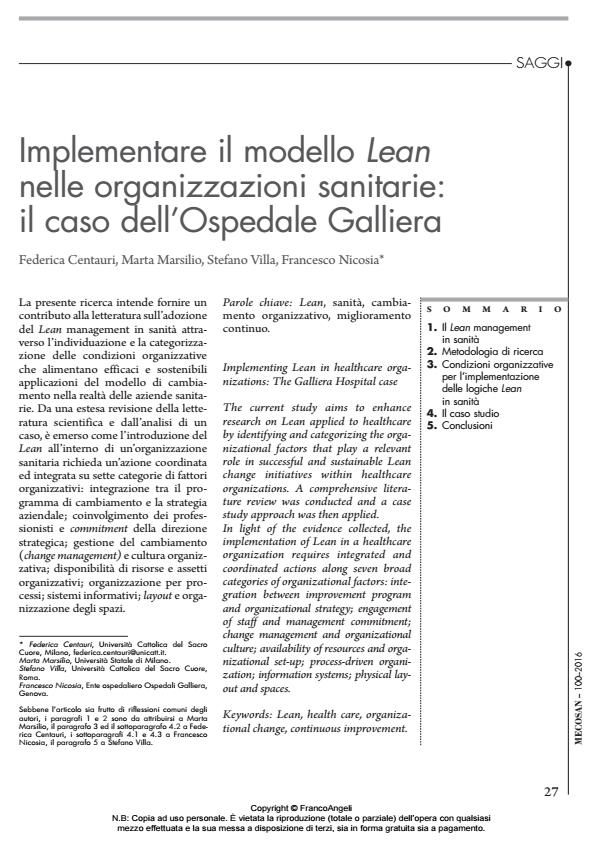Implementing Lean in healthcare organizations: The Galliera Hospital case
Journal title MECOSAN
Author/s Federica Centauri, Marta Marsilio, Stefano Villa, Francesco Nicosia
Publishing Year 2017 Issue 2016/100
Language Italian Pages 29 P. 27-55 File size 23844 KB
DOI 10.3280/MESA2016-100003
DOI is like a bar code for intellectual property: to have more infomation
click here
Below, you can see the article first page
If you want to buy this article in PDF format, you can do it, following the instructions to buy download credits

FrancoAngeli is member of Publishers International Linking Association, Inc (PILA), a not-for-profit association which run the CrossRef service enabling links to and from online scholarly content.
The current study aims to enhance research on Lean applied to healthcare by identifying and categorizing the organizational factors that play a relevant role in successful and sustainable Lean change initiatives within healthcare organizations. A comprehensive literature review was conducted and a case study approach was then applied. In light of the evidence collected, the implementation of Lean in a healthcare organization requires integrated and coordinated actions along seven broad categories of organizational factors: integration between improvement program and organizational strategy; engagement of staff and management commitment; change management and organizational culture; availability of resources and organizational set-up; process-driven organization; information systems; physical layout and spaces.
Keywords: Lean, health care, organizational change, continuous improvement.
- LEAN, WORK AND PSYCHOLOGICAL WELL-BEING Carla Garoni, Fabrizio Dori, Caterina Bianciardi, Federica Centauri, Jacopo Guercini, Fabio Biancalani, in Giornale Italiano di Medicina del Lavoro ed Ergonomia /2025 pp.29
DOI: 10.4081/gimle.436 - Strutturare il cambiamento organizzativo negli ospedali: l'esperienza dell'Ufficio Lean dell'AOU Senese Federica Centauri, Jacopo Guercini, Caterina Bianciardi, Vincenzo Mezzatesta, in MECOSAN 104/2018 pp.51
DOI: 10.3280/MESA2017-104004
Federica Centauri, Marta Marsilio, Stefano Villa, Francesco Nicosia, Implementare il modello Lean nelle organizzazioni sanitarie: il caso dell’Ospedale Galliera in "MECOSAN" 100/2016, pp 27-55, DOI: 10.3280/MESA2016-100003